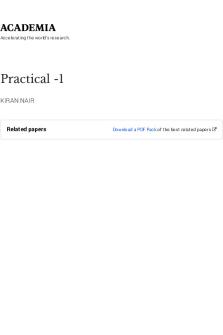Linear AIR Track 1 - PRACTICAL PDF

| Title | Linear AIR Track 1 - PRACTICAL |
|---|---|
| Author | KHOMOTSO robert sebata |
| Course | Mathematics Engineering 1 |
| Institution | University of South Africa |
| Pages | 13 |
| File Size | 547.6 KB |
| File Type | |
| Total Downloads | 291 |
| Total Views | 995 |
Summary
ABSTRACTLINEAR AIR TRACKTitle for part 1: TO MEASURE THE FLATNESS OF A LINEAR AIR TRACK.Title part 2: To determine the coefficient of restitution.NAME OF INSTITUTION: UNISANAME OF COURSE: (CHEMICAL ENGINEERING)MODULE CODE: FIC1501 Practical WorkSTUDENT NAME: ISRAEL RATSHILISTUDENT NUMBER: 69262705DA...
Description
ABSTRACT
LINEAR AIR TRACK
Title for part 1: TO MEASURE THE FLATNESS OF A LINEAR AIR TRACK. Title part 2: To determine the coefficient of restitution.
NAME OF INSTITUTION: UNISA NAME OF COURSE: (CHEMICAL ENGINEERING)
MODULE CODE: FIC1501 Practical Work STUDENT NAME: ISRAEL RATSHILI STUDENT NUMBER: 69262705 DATE OF EXPERIMENT: 18 FEBRUARY 2021
1|Page
ABSTRACT
The aim of this linear air track experiment was to determine the flatness of the linear air track and the second part was to determine the coefficient of restitution. In order to determine the flatness of the air track a glider was placed on the air track, this glider has a piece of metal called a flag inserted horizontally or vertically in our case it was the latter.
Furthermore, the air track had 4 photogates placed at 30cm intervals, these photogates were connected to the PASCO software. The aforementioned software would record the velocity and time of the glider when the glider passes each photogate. In conclusion for the first part of this experiment I found that the size of the flag was very important because the smaller the size of the flag, the greater the percentage error. For the second part of the experiment the coefficient of restitution was found to be 0,740 It is important to remember that this coefficient is used to determine the elasticity of a collision. It determined that the collision for my experiment to be semi-elastic.
INTRODUCTION The aim of this experiment is to determine the flatness of a linear air track ,using a glider that has a flag attached/ inserted on to it. This flag is what is going to be sensed by the 4 photogates placed on the linear air track these photogates are placed at 30 cm intervals.
2|Page
THEORY
This practical report is divided into two parts, part 1 and part 2. Part 1 of this practical is about the flatness of a linear air track. A linear air track is a device used to study motion in an environment with little to no friction. This is because an air track is a perforated rail which is connected to an air blower. Compressed air comes out and fills the holes and forms a thin layer of air on the surface of the track. this layer fills the space between the air track and the inner surface of a metal glider.
Each metal glider has a slot on it where a piece of metal plate can be inserted. The aforementioned plate is called a flag which can be place vertically or horizontally on the glider. The size of the flag I used is 2.4cm or 0,024m. The linear air track also has photogates placed at constant intervals. For our experiment the 4 photogates were placed at 30 cm intervals, these photogates were connected to a PASCO SOFTWARE this software would record the velocity and time when the flag placed or inserted on a glider passes each photogate.
Part 2 of this experiment was to determine the coefficient of restitution, e. The coefficient of restitution is used to determine whether a rebound or collision is elastic, semi-elastic or non – elastic. A collision is perfectly elastic if the relative velocity has the same magnitude before and after said collision and e=1. Furthermore, if the relative velocity, is smaller in magnitude after a collision the collision is said to be semi- elastic and 0...
Similar Free PDFs

Linear AIR Track 1 - PRACTICAL
- 13 Pages

Air Track Answers - bchvchfhdjce
- 5 Pages

Air Track SE - physics
- 13 Pages

Gizmo - Air Track
- 10 Pages

Air Track gizmo Answers
- 5 Pages

Practical -1
- 20 Pages

Fisiologi hewan air(1)
- 39 Pages

Linear Algebra-Chapter 1
- 11 Pages

Stock-Track requirements
- 1 Pages

Lab #1: Linear Kinematics
- 6 Pages

Lab practical 1
- 5 Pages
Popular Institutions
- Tinajero National High School - Annex
- Politeknik Caltex Riau
- Yokohama City University
- SGT University
- University of Al-Qadisiyah
- Divine Word College of Vigan
- Techniek College Rotterdam
- Universidade de Santiago
- Universiti Teknologi MARA Cawangan Johor Kampus Pasir Gudang
- Poltekkes Kemenkes Yogyakarta
- Baguio City National High School
- Colegio san marcos
- preparatoria uno
- Centro de Bachillerato Tecnológico Industrial y de Servicios No. 107
- Dalian Maritime University
- Quang Trung Secondary School
- Colegio Tecnológico en Informática
- Corporación Regional de Educación Superior
- Grupo CEDVA
- Dar Al Uloom University
- Centro de Estudios Preuniversitarios de la Universidad Nacional de Ingeniería
- 上智大学
- Aakash International School, Nuna Majara
- San Felipe Neri Catholic School
- Kang Chiao International School - New Taipei City
- Misamis Occidental National High School
- Institución Educativa Escuela Normal Juan Ladrilleros
- Kolehiyo ng Pantukan
- Batanes State College
- Instituto Continental
- Sekolah Menengah Kejuruan Kesehatan Kaltara (Tarakan)
- Colegio de La Inmaculada Concepcion - Cebu




